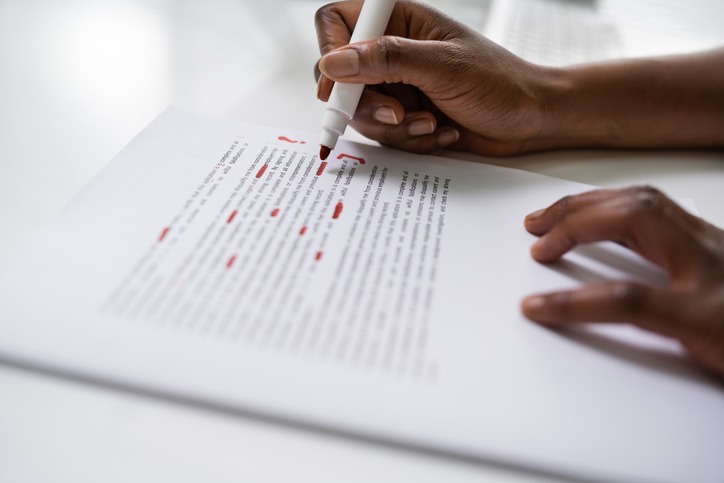20 essential editing tips
Use these tactics to tighten, brighten and enhance whatever sloppy copy comes your way.

Editing is vital to produce great writing. But what’re the best ways to trim, polish and strengthen copy?
This list offers essential proofreading tips to whip your work into professional shape:
1. Sleep on it.
Editing requires a clear, objective mind, which can be difficult to maintain if you’re trying to finish too much in one day. Resting your mind between edits gives your eyes a better chance to catch errors.
Even for short documents finished in a few hours, look at them again the next day.
2. Pore over the document at different times of day.
Even though I’m not a morning person, I’ve found I gain a fresh perspective on my work the next morning.
If I’m reading a document all morning, however, it can be helpful to take a look at it again the next day at night.
Vary your editing times, and it’ll feel like a different document. You’ll see new elements you likely missed before.
3. Read your writing out loud.
When you’re reading silently, your eyes can jump over the words on the page. This means you can miss errors or fail to realize your sentences are actually missing words. To self-edit properly, read your writing out loud, and listen to how it sounds. Your tongue won’t say a word that’s wrong or missing, and your ears will catch the mistake.
Also, any sentences that you find difficult to say out loud may be difficult for your readers. Fix those sentences.
4. Keep an error list.
It’s helpful to keep a running list of common writing blunders.
Some writers frequently miss the difference between “it’s” and “its,” or they type “effect” when they mean “affect.” If you consistently make any specific errors, write those down, too.
Then, when you get to the editing stage, search for troublesome words using the “find” feature in your word processor.
5. Keep a list of difficult words nearby.
Certain words always trouble me. I can never quite get “reminisce” right on the first try. I always forget whether it’s “combatting” or “combating.”
To save time, create a list of words that you find difficult, and keep it nearby when you edit.
6. Give it time.
Some writers devote little time in their schedules to editing and proofreading. This is a mistake.
Writing often eats up a ton of time, while the editing and proofreading gets compressed into a few hours. You cannot catch errors, however, when you’re rushing through it. Schedule plenty of time for the proofing process.
7. Use a style guide from the beginning.
Before you start drafting, clarify which style guide you’ll be adhering to. It may be the APA or MLA guide or the Chicago Manual of Style. Perhaps your organization has its own house style?
Whatever it is, style guides will help you ensure consistent spelling, capitalization and formatting right from the start. That way you don’t have to spend hours at the end changing all of these elements.
8. Print it out in a different layout.
The traditional double-spaced, single-column layout in your word processor is not the best way to proofread. We’re so used to it, but our eyes have to follow lines all the way across six inches or so.
That’s why it’s helpful to change the layout size – perhaps to 4 x 8 inches – or use double columns to make the width of a line shorter. This can help you see errors better.
9. Avoid distractions when proofreading.
Distractions can ruin any proofreading session. If you’ve got a child running around or a conversation between co-workers going on behind you, it’s almost impossible to concentrate.
Find a quiet room without any access to the internet and email. Checking email continuously, even passively, pulls you out of the proofreading mindset, and then it takes time to rebuild your focus.
10. Be consistent in your changes.
Writers often make changes to some part of a document but not all. They may replace short dashes with long dashes for the first 20 pages and then leave the short dashes for the rest of the document.
Be consistent in the changes you make. If you change the style of something on page one, make sure you change the style of a similar thing on page 100.
11. Get a trusted friend to read your writing.
Some people – particularly students – seem to think writing should be a solitary act.
In reality, you should share your drafts with a trusted friend to get opinions, suggestions and honest feedback. You can never have too many sets of eyes.
12. Don’t edit while you’re drafting.
Write your initial drafts without judging them or making corrections as you go. Don’t think about spelling, grammar or style while you’re writing. Save that for the editing process.
13. Edit and proofread other people’s work.
Practice makes perfect. The same goes with editing, so make sure you’re editing other people’s copy frequently.
Beyond enhancing your skills, this is a good opportunity to develop a relationship with an editing buddy. Share your work with each other to keep your editing eyes sharp.
14. Don’t edit forever.
The editing stage is vital, but it’s also just a stage. And it’s a stage you should get through in a reasonable amount of time.
Now, that amount of time depends on the document. But the perfectionists among us never want to submit anything to editors until it’s absolutely perfect. Do a thorough job, but know when to hit “submit.”
15. Use Track Changes in Word when editing.
The Track Changes feature in Microsoft Word highlights any changes made to a document while preserving the original text. This way you can revert back to original phrasing if you change your mind. Always turn this feature on, and you won’t become so scared about changing your phrasing permanently.
16. Use a red pen when proofreading on paper.
When you’re typing in changes from a proofreading session, you may miss some of your markup suggestions if you used a pencil or black pen. Try using a red pen, and the corrections will glare at you.
17. Read other people’s great writing.
Are you reading enough these days? Make sure to challenge yourself to consistently consume superb writing and storytelling.
Reading exceptional writing is one way to learn how to edit your own work. You’ll see new options for recasting sentences, and you’ll find inspiration for new ideas. Learn from the best,
18. Read a good grammar book.
Reading about writing might not be the most scintillating material. But a periodic visit with Strunk and White or Zinsser will help you get back to the basics.
Reading about grammar also keeps your editing mind fresh, as you remind yourself of what you’re looking for.
19. Hire a professional.
If you’re really busy, there’s no shame in hiring a professional to do the editing and proofreading for you. Professionals can work magic on a rough draft.
20. Work that muscle.
Find ways to keep your editing and proofreading muscles strong. Professional athletes know they must practice almost every day to stay fit and coordinated. It’s no different with editing and proofreading.
When you get away from doing these tasks, you lose some of your sense for errors. If you have no writing of your own to review, edit a page on the web every few days to stay in top form.
Dr. Duncan Koerber is a professor and freelance editor. Read more of his work on The Expert Editor.






